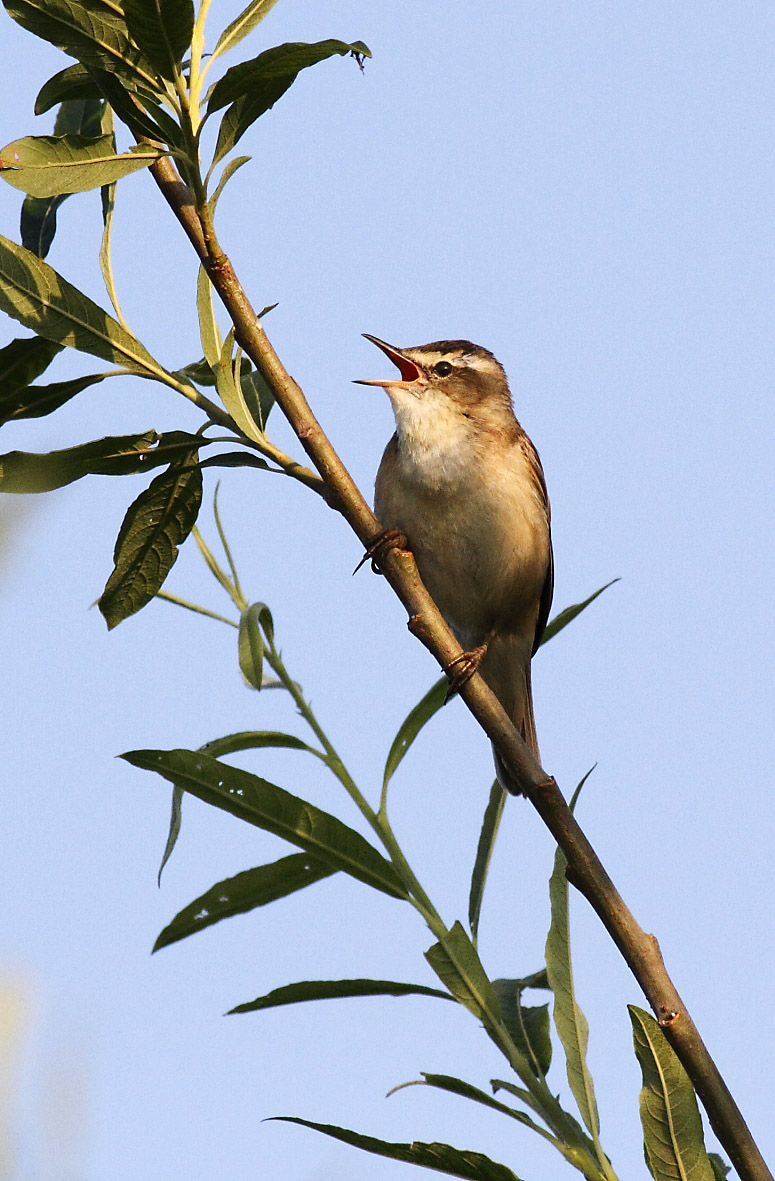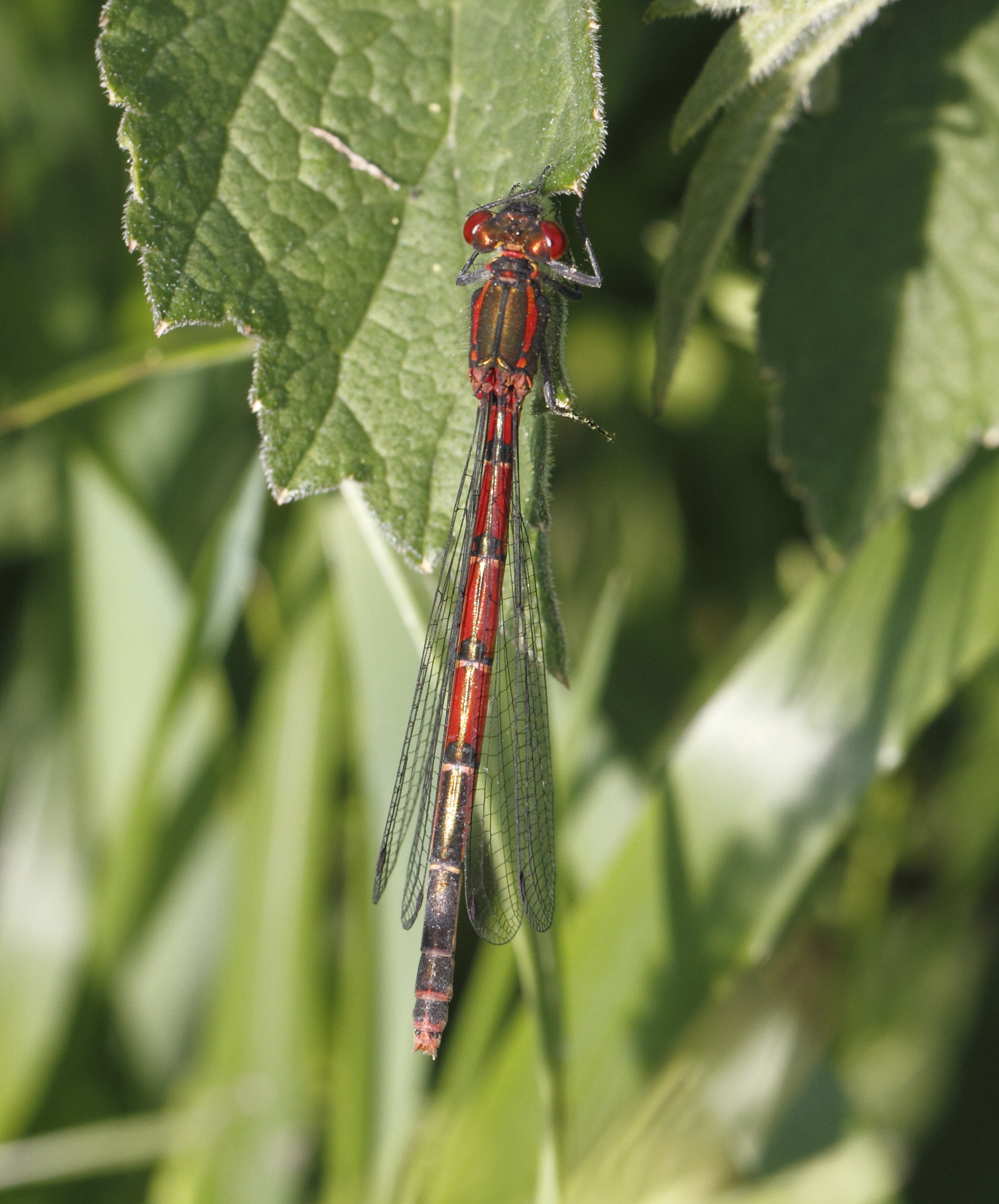Summer
This is the busiest time of year for everything. Breeding is the main game in town. This too is the time for the annual hay cut leaving wide margins at the boundaries it removes noxious weeds and helps to reduce the vigour of the grass which in turn encourages wild flowers.

Plants
Meadowsweet and Purple Loosestrife add colour and fragrance to the summer wetlands while the meadows turn yellow with buttercups. Late summer brings the spikes of flowering Wild Teasel, mauve against the blue sky, a favourite with  bees for their rich nectar.
bees for their rich nectar.
Water Plantain and Amphibious Bistort are both common on the wetlands. Water Plantain looks like something from a tropical garden, with its large, broad, pointed leaves and flower spikes poking out of the water contrasting with the tall slender growth of reeds.
Amphibious Bistort, as its name suggests is at home on land as it is in water, which means it copes extremely well with the fluctuating water levels in the wetland pools, its pink flower spikes adding a splash of colour.
We have a couple of unusual plants on the wetlands, which you may well miss unless you know what you’re looking for. Celery-leaved Buttercup and Tubular Water Dropwort, both with wonderful names and a quite unassuming appearance are both found in the damp areas around the wetland pools.
Birds
 Around 46 species breed close to Avon Meadows of which 37 have been known to breed within the boundary. Buzzing of Sedge and Reed Warblers from the reed beds indicates that they are doing well. These, together with the Dunnock, play host to the huge chicks of the Common Cuckoo.
Around 46 species breed close to Avon Meadows of which 37 have been known to breed within the boundary. Buzzing of Sedge and Reed Warblers from the reed beds indicates that they are doing well. These, together with the Dunnock, play host to the huge chicks of the Common Cuckoo.
Nest boxes are mainly occupied by Blue and Great Tits. Other small birds breed in the dense stands of Blackberry and Hawthorn including Robin, Song Thrush and Long-tailed Tit.
Butterflies & Moths
Meadow Browns, Ringlets and Gatekeepers are a common summer sight, around the grassy areas. Small Copper and Common Blue butterflies inhabit grassy banks in summer to delight the observer.
Thanks to the Big Lottery Fund through Awards for All, the Friends of Avon Meadows have been able to buy two moth traps, which we hope will go a long way to increasing the number of records we have for night flying moths.
Many moths have the most beautiful names and with 369 species of moth recorded on the wetland, it can be quite a challenge to identify them all.
Some of our recent sightings include the Brimstone moth, Angle Shades, Blood-vein, Double-striped Pug, Poplar Hawkmoth and the Feathered Gothic to name but a few.
Insects
 Creepy crawlies are not everyone’s favourite, but the meadows are teeming with insects; spiders, snails, beetles, craneflies, ants, woodlice, and even leeches (although not the human bloodsucking kind!).
Creepy crawlies are not everyone’s favourite, but the meadows are teeming with insects; spiders, snails, beetles, craneflies, ants, woodlice, and even leeches (although not the human bloodsucking kind!).
This abundance of life in the undergrowth is the powerhouse behind all the other more glamorous and showy species, with invertebrates providing the food for many of the birds, fish and mammals that live on and around the meadows.
Bug hunting can be great fun and spark a lasting passion for the natural world. There are so many species, so much variety, that finding out about spiders or learning about all the different types of cranefly can become a lifelong journey of exploration and discovery.
Our invertebrate records for the meadows are far from complete, but we do have some interesting sightings. Water Ladybirds are found in the wetland areas.
Smaller than their garden counterparts and often pale beige, turning red in spring, they have anywhere between 15 and 21 black spots.
Although not an insect, the Horse Leech is occasionally found on the meadows. The name is completely misleading, their teeth are in no way adapted for feeding on horses (or humans), instead their prey is earthworms and insect larvae.
 The wonderfully and aptly named Thick-legged Flower Beetle is a beautiful metallic green bug that is just exactly as its name suggests, just over a centimetre long with thighs that seem that they have been over-inflated and it’s frequently found in and around flowers.
The wonderfully and aptly named Thick-legged Flower Beetle is a beautiful metallic green bug that is just exactly as its name suggests, just over a centimetre long with thighs that seem that they have been over-inflated and it’s frequently found in and around flowers.
Dragonflies and Damselflies can be easy to spot, but can be very hard to identify as they dart around, rarely settling where they can be seen clearly.
Damselflies are smaller than Dragonflies and when they rest, hold their wings alongside their body, rather than outstretched as dragonflies do.
19 species of dragonfly and damselfly have been recorded on the wetlands, including the unusual Red-eyed Damselfly.
Female damselflies can be much less brightly coloured than the males, in various shades of brown, gold or green. May sees the appearance of the first of this group, usually the Large Red Damselfly.
Banded Demoiselles cluster around the Piddle Brook and along the river, the males are a bright blue, with large smudgy black spots on their wings, like someone has picked them up with dirty fingers.
 Common Blue Damselflies are, as their name suggests, are a common sight on most wetland habitats, but there are a few other damselflies that look very similar at a casual glance, like the Azure Damselfly and the Blue-tailed Damselfly which are both common.
Common Blue Damselflies are, as their name suggests, are a common sight on most wetland habitats, but there are a few other damselflies that look very similar at a casual glance, like the Azure Damselfly and the Blue-tailed Damselfly which are both common.
The experienced spotter looks for the different arrangement of black and blue segments on the body to quickly identify the correct species.
Dragonflies can be extremely territorial, patrolling the boundary of their pool and seeing off any intruders that stray into their patch.
Electric blue and green Emperor Dragonflies, Britain's largest dragonfly, fly silently around their pools from June onwards, occasionally settling on a leaf or a twig, but more often than not endlessly sweeping their domain for intruders or insects to catch and eat.
Their cousins, the hawkers, appear around the same time when Brown and Southern Hawkers serve to confuse the observer.
Male Broad-bodied Chasers are a beautiful powder blue across most of their bullet-shaped bodies, except for a couple of bright gold patches on their sides.
They will land on the ground, tantalisingly close, but as soon as you get close enough, perhaps to get your camera out, they will flit away again, to land once more, just out of range.
Mammals
Small mammals love the long tussocky grass, creating tunnel runs through it to keep themselves hidden from the ever watchful gaze of Kestrels and cats.
Water and Common Shrew are both found on the wetland, but they tend to stay well clear of areas where people and dogs walk.
We know that Otters have been spotted nearby recently. Some 40 years ago, otters were practically extinct in Worcestershire, only a few surviving on the borders with Shropshire.
A combination of pesticides and pollutants had impacted on their food and habitat, but with protection and careful conservation activity, otters have come back into our rivers, a sign that water quality has improved and there is enough food to support a healthy otter population.
Otters face competition from a voracious invader, the American Mink. Smaller than an otter, mink can get into riverbank burrows and will tackle prey many times their own size.
It’s thought that mink are responsible for the decline in our native water vole population, a species that would be a welcome sight on the wetlands, unlike American Mink.
We believe that mink are active on the wetland and were probably responsible for the death of a number of cygnets and one adult Mute Swan in 2013.
Bats are definitely using the wetlands to feed.
With the help of a bat detector, volunteers have identified the clicks and squeaks of 8 different species of bat as they hunt high along the hedgerows and skim over the water, using those clicks to locate and catch their insect prey.
Photographs © Richard Stott
